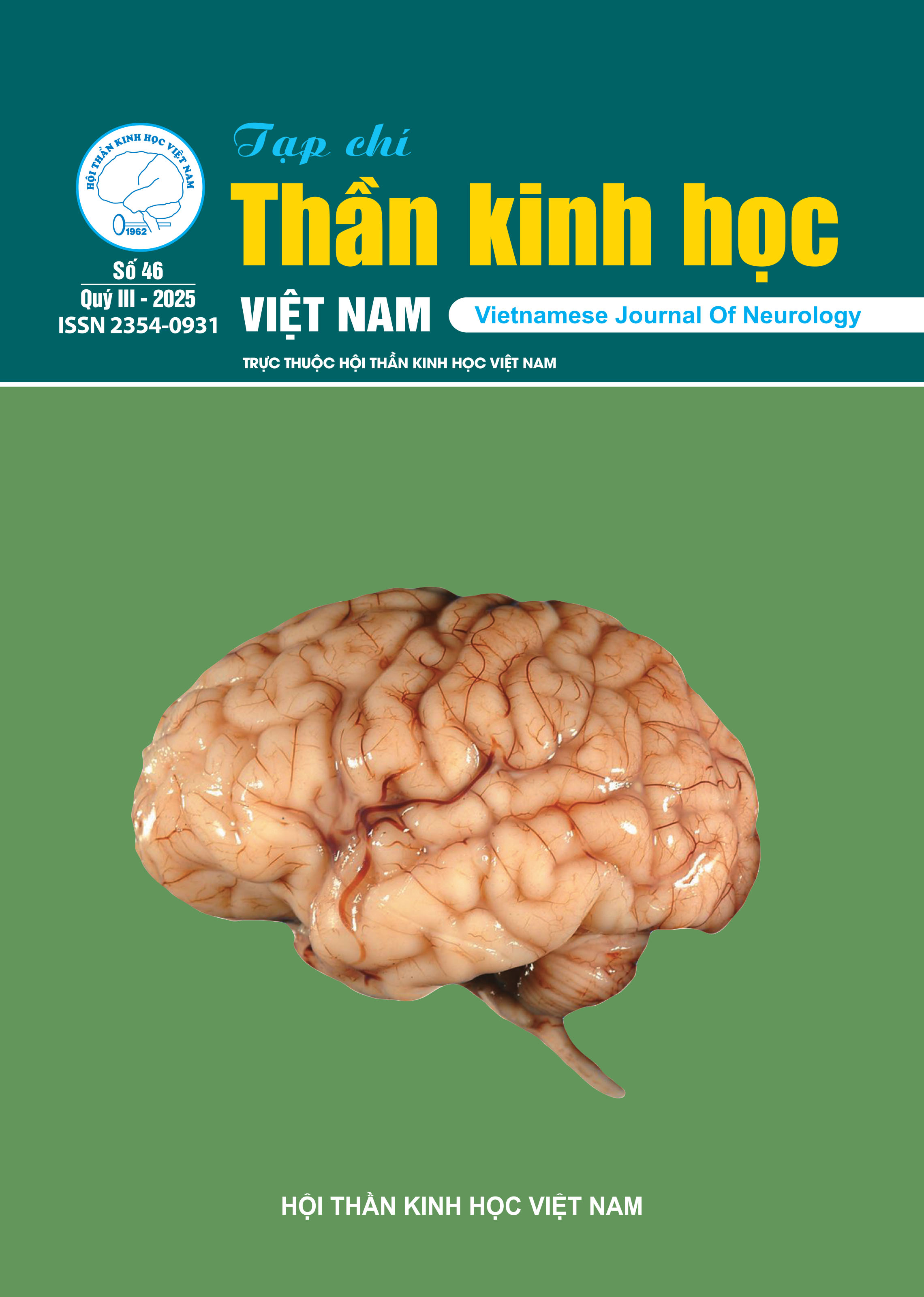Nhận thức, thái độ và các yếu tố liên quan của điều dưỡng sau khi được đào tạo khung giao tiếp sbar trong bàn giao thông tin người bệnh tại Trung tâm Phẫu thuật Thần kinh, Bệnh viện Hữu Nghị Việt Đức năm 2024

DOI:
https://doi.org/10.62511/vjn.46.2025.066Từ khóa:
Nhận thức thái độ SBAR điều dưỡngLượt tải xuống
Đã xuất bản
Số tạp chí
Chuyên mục
Thể loại
Cách trích dẫn
Tóm tắt
Đặt vấn đề: Bàn giao người bệnh là một trong những điểm then chốt trong quá trình chăm sóc, ảnh hưởng trực tiếp đến sự an toàn và hiệu quả điều trị. Mô hình giao tiếp SBAR (Situation, Background, Assessment, Recommendation) được khuyến nghị nhằm chuẩn hóa nội dung trao đổi, hạn chế sai sót và tăng cường phối hợp giữa các nhân viên y tế.
Mục tiêu: Mô tả nhận thức, thái độ và các yếu tố liên quan của điều dưỡng sau đào tạo SBAR tại Trung tâm Phẫu thuật Thần kinh, Bệnh viện Hữu nghị Việt Đức năm 2024.
Phương pháp: Nghiên cứu mô tả cắt ngang được thực hiện trên 87 điều dưỡng sử dụng bộ câu hỏi chuẩn hóa, gồm thang đo nhận thức, thái độ. Phân tích số liệu bằng SPSS 20.0 với thống kê mô tả và suy luận.
Kết quả: Điểm trung bình nhận thức, thái độ lần lượt là 13,03 ± 1,97; 31,53 ± 8,27. Khoa công tác, trình độ học vấn và số lần đào tạo có liên quan có ý nghĩa thống kê với nhận thức của điều dưỡng sau đào tạo SBAR
Kết luận: Việc đào tạo SBAR có hiệu quả bước đầu, tuy nhiên cần lặp lại định kỳ và điều chỉnh theo đặc thù từng khoa/phòng nhằm nâng cao tính ứng dụng trong thực tiễn lâm sàng.
Tài liệu tham khảo
Reime MH, Tangvik LS, Kinn-Mikalsen MA, Johnsgaard T. Intrahospital Handovers before and after the Implementation of ISBAR Communication: A Quality Improvement Study on ICU Nurses’ Handovers to General Medical Ward Nurses. Nurs Rep. 2024 Sep;14(3):2072–83.
DOI: https://doi.org/10.3390/nursrep14030154

Müller M, Jürgens J, Redaèlli M, Klingberg K, Hautz WE, Stock S. Impact of the communication and patient hand-off tool SBAR on patient safety: a systematic review. BMJ Open. 2018 Aug 23;8(8):e022202.
DOI: https://doi.org/10.1136/bmjopen-2018-022202

Yun J, Lee YJ, Kang K, Park J. Effectiveness of SBAR-based simulation programs for nursing students: a systematic review. BMC Med Educ. 2023 Jul 14;23:507.
DOI: https://doi.org/10.1186/s12909-023-04495-8

Shahid S, Thomas S. Situation, Background, Assessment, Recommendation (SBAR) Communication Tool for Handoff in Health Care – A Narrative Review. Saf Health. 2018 Jul 28;4(1):7.
DOI: https://doi.org/10.1186/s40886-018-0073-1

Toumi D, Dhouib W, Zouari I, Ghadhab I, Gara M, Zoukar O. The SBAR tool for communication and patient safety in gynaecology and obstetrics: a Tunisian pilot study. BMC Med Educ. 2024 Mar 5;24(1):239.
DOI: https://doi.org/10.1186/s12909-024-05210-x

Randmaa M, Mårtensson G, Leo Swenne C, Engström M. SBAR improves communication and safety climate and decreases incident reports due to communication errors in an anaesthetic clinic: a prospective intervention study. BMJ Open. 2014 Jan 21;4(1):e004268.
DOI: https://doi.org/10.1136/bmjopen-2013-004268

Uhm JY, Ko Y, Kim S. Implementation of an SBAR communication program based on experiential learning theory in a pediatric nursing practicum: A quasi-experimental study. Nurse Educ Today. 2019 Sep 1;80:78–84.
DOI: https://doi.org/10.1016/j.nedt.2019.05.034

Lazzari C. Implementing the Verbal and Electronic Handover in General and Psychiatric Nursing Using the Introduction, Situation, Background, Assessment, and Recommendation Framework: A Systematic Review. Iran J Nurs Midwifery Res. 2024 Jan 9;29(1):23–32.
DOI: https://doi.org/10.4103/ijnmr.ijnmr_24_23

Raeisi A, Rarani MA, Soltani F. Challenges of patient handover process in healthcare services: A systematic review. J Educ Health Promot. 2019 Sep 30;8:173.
DOI: https://doi.org/10.4103/jehp.jehp_460_18

Nagammal S, Nashwan AJ, Nair SL, Susmitha A. Nurses’ perceptions regarding using the SBAR tool for handoff communication in a tertiary cancer center in Qatar. J Nurs Educ Pract. 2016 Dec 6;7(4):103.
DOI: https://doi.org/10.5430/jnep.v7n4p103

Girsang E, Nasution SLR, Fatmah AU, Cristy M. The Effect of SBAR Communication on Nurse Attitude and Behavior in Increasing Patient Safety in KRMT Wongsonegoro Hospital, Semarang.

Farzaneh M, Saidkhani V, Ahmadi Angali K, Albooghobeish M. Effectiveness of the SBAR-Based training program in self-efficacy and clinical decision-making of undergraduate anesthesiology nursing students: a quasi-experimental study. BMC Nurs. 2023 Apr 27;22:145.
DOI: https://doi.org/10.1186/s12912-023-01290-0

Yu M, Kang KJ. Effectiveness of a role-play simulation program involving the sbar technique: A quasi-experimental study. Nurse Educ Today. 2017 Jun;53:41–7.
DOI: https://doi.org/10.1016/j.nedt.2017.04.002

Ding Y, Wang G, Chen H, Kang J, Wu Z. Application Effects of SBAR Communication Mode in ICU Nursing Physical Restraint Shift. Altern Ther Health Med. 2022 Sep;28(6):112–7.

Moi EB, Söderhamn U, Marthinsen GN, Flateland SM. The ISBAR tool leads to conscious, structured communication by healthcare personnel. Sykepl Forsk. 2019;(74699):e-74699.
DOI: https://doi.org/10.4220/Sykepleienf.2019.74699en

Haddeland K, Marthinsen GN, Söderhamn U, Flateland SMT, Moi EMB. Experiences of using the ISBAR tool after an intervention: A focus group study among critical care nurses and anaesthesiologists. Intensive Crit Care Nurs. 2022 Jun;70:103195.
DOI: https://doi.org/10.1016/j.iccn.2021.103195

Nguyễn Thị Kim Quyên và cộng sự, Kiến thức, thái độ, thực hành bàn giao ca trực theo công cụ SBAR của nhân viên y tế tại Bệnh viện Đại học Y Dược TPHCM - Cơ sở 2. Tạp chí Y Dược Thực hành 175. 2022.
DOI: https://doi.org/10.59354/ydth175.2022.15

Cao Thị Thiêm và cộng sự. Yếu tố liên quan đến bàn giao người bệnh theo mô hình SBAR của điều dưỡng tại bệnh viện Đa khoa quốc tế Vinmec times city. Tạp chí y học Việt Nam tập 527. 2023.
DOI: https://doi.org/10.51298/vmj.v527i1.5687

Wang W, Liang Z, Blazeck A, Greene B. Improving Chinese nursing students’ communication skills by utilizing video-stimulated recall and role-play case scenarios to introduce them to the SBAR technique. Nurse Educ Today. 2015 Jul;35(7):881–7.
DOI: https://doi.org/10.1016/j.nedt.2015.02.010

Cooper D, Clark PC. Preliminary Psychometrics of the Knowledge and Attitudes Toward SBAR Instrument (KA-SBAR). J Dr Nurs Pract. 2020 Jul 1;13(2):120–4. 27.
DOI: https://doi.org/10.1891/JDNP-D-19-00058










